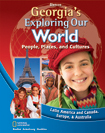Exploring Our World: Latin America and Canada, Europe, and Australia © 2012 Georgia EditionChapter 4:
Physical Geography of Latin AmericaWeb Activity Lesson PlansIntroduction
In this chapter, students learned about the diverse geography of Latin America, including its many waterways. The world's second-longest river, the Amazon, serves as a transportation route and helps sustain more than one-third of all species in the world. This Web site contains articles on many aspects of the river and the region through which it winds. The site has photographs and video of various animals that live near the Amazon River. Lesson Description
Students will visit the Amazon portion of the World Wildlife Organization Web site. They will read information about the river itself, deforestation, and species living in the rain forest. Students will answer questions about what they have read and have an opportunity to share what they have learned by sending an Ecard. Instructional Objectives
- The learner will learn about the Amazon River and region.
- The learner will describe reasons for deforestation and the effects climate change may have on the species that live there.
- The learner will share what they have learned about the unique species and ecosystem of the Amazon.
Student Web Activity Answers
- Amazon
- 40,000
- manatee
- commercial agriculture, including soybean farming and cattle ranching; unsustainable subsistence farming; and major road construction
- The area is likely to become a savannah, killing the plants and animals that thrive in a rain forest habitat.
- Students' choices of unique species will vary. They should provide 2 or 3 facts described on the site as rationale for their choices.
 | 

















